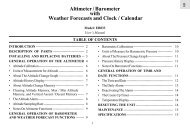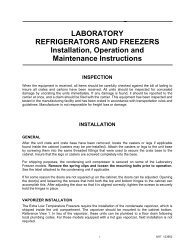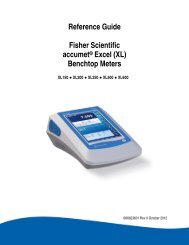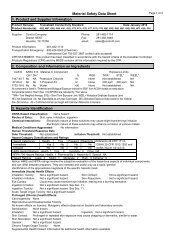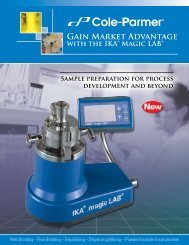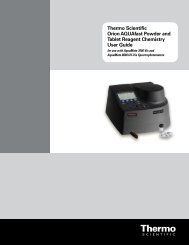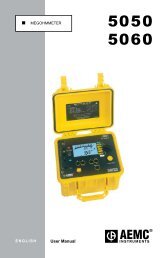- Page 1 and 2:
UV-VisOrion AquaMate 7000 VisOrion
- Page 3 and 4:
CContentsPreface . . . . . . . . .
- Page 7 and 8:
ContentsChapter 24 Parameters . . .
- Page 9 and 10:
PPrefaceCongratulations on your pur
- Page 11 and 12:
1Spectrophotometer BasicsThis chapt
- Page 13 and 14:
1 Spectrophotometer BasicsSpectroph
- Page 15 and 16:
1 Spectrophotometer BasicsSelecting
- Page 17 and 18:
2Setting Up the InstrumentSetting u
- Page 19 and 20:
2 Setting Up the InstrumentSetting
- Page 21 and 22:
2 Setting Up the InstrumentSetting
- Page 23 and 24:
3AccessoriesThis chapter briefly de
- Page 25 and 26:
3 AccessoriesCell Holders and Cell
- Page 27 and 28:
3 AccessoriesExternal PrintersNote
- Page 29 and 30:
4Sample Positioner SettingThe spect
- Page 31 and 32:
5Cell CorrectionEvery test setup sc
- Page 33 and 34:
5 Cell CorrectionCell Correction7.
- Page 35 and 36:
6Managing Stored TestsThe instrumen
- Page 37 and 38:
6 Managing Stored TestsSaving a Tes
- Page 39 and 40:
6 Managing Stored TestsLock/UnlockN
- Page 41 and 42:
7SmartStartThe SmartStart feature l
- Page 43 and 44:
8Concentration UnitsThis chapter co
- Page 45 and 46:
9Calculator FunctionTo use the Calc
- Page 47 and 48:
10Water Analysis ApplicationThe Wat
- Page 49 and 50:
10 Water Analysis ApplicationRunnin
- Page 51 and 52:
10 Water Analysis ApplicationProgra
- Page 53 and 54:
10 Water Analysis ApplicationUsing
- Page 55 and 56:
10 Water Analysis ApplicationUsing
- Page 57 and 58:
10 Water Analysis ApplicationUsing
- Page 59 and 60:
10 Water Analysis ApplicationUsing
- Page 61 and 62:
11Abs and %T Measurements—Basic A
- Page 63 and 64:
12Abs and %T Measurements—Advance
- Page 65 and 66:
12 Abs and %T Measurements—Advanc
- Page 67 and 68: 13Basic Concentration Measurements
- Page 69 and 70: 13 Basic Concentration Measurements
- Page 71 and 72: 14Concentration Measurements—Adva
- Page 73 and 74: 14 Concentration Measurements—Adv
- Page 75 and 76: 15ScanningThe wavelength scanning a
- Page 77 and 78: 15 ScanningScanning a Sample2. Plac
- Page 79 and 80: 15 ScanningViewing and Manipulating
- Page 81 and 82: 15 ScanningViewing and Manipulating
- Page 83 and 84: 15 ScanningViewing and Manipulating
- Page 85 and 86: 16MultiwavelengthThe Multiwavelengt
- Page 87 and 88: 16 MultiwavelengthTaking Measuremen
- Page 89 and 90: 17Absorbance RatioThe Absorbance Ra
- Page 91 and 92: 17 Absorbance RatioMeasuring Sample
- Page 93 and 94: 18Absorbance DifferenceThe Absorban
- Page 95 and 96: 18 Absorbance DifferenceMeasuring S
- Page 97 and 98: 193-Point NetThe 3-Point Net applic
- Page 99 and 100: 19 3-Point NetTaking Measurements2.
- Page 101 and 102: 20Concentration Measurements—Stan
- Page 103 and 104: 20 Concentration Measurements—Sta
- Page 105 and 106: 20 Concentration Measurements—Sta
- Page 107 and 108: 20 Concentration Measurements—Sta
- Page 109 and 110: 21KineticsThe Kinetics application
- Page 111 and 112: 21 KineticsMeasuring SamplesParamet
- Page 113: 21 KineticsRecalling and Recalculat
- Page 116 and 117: 21 KineticsRescaling and Recalculat
- Page 120 and 121: 22 Performance VerificationWaveleng
- Page 122 and 123: 22 Performance VerificationResoluti
- Page 124 and 125: 22 Performance VerificationPhotomet
- Page 126 and 127: 22 Performance VerificationStray Li
- Page 128 and 129: 22 Performance VerificationStray Li
- Page 130 and 131: 23 MaintenanceRoutine CareCleaning
- Page 132 and 133: 23 MaintenanceChanging the FuseIMPO
- Page 134 and 135: 23 MaintenanceReplacing the Tungste
- Page 136 and 137: 23 MaintenanceReplacing the Tungste
- Page 138 and 139: 24 ParametersParameterCalculatorCel
- Page 140 and 141: 24 ParametersParameterFactor 2Facto
- Page 142 and 143: 24 ParametersParameterNumber of Sta
- Page 144 and 145: 24 ParametersParameterDescriptionTa
- Page 146 and 147: 25 Calculations for SoftwareCalcula
- Page 148: 25 Calculations for SoftwareCalcula



